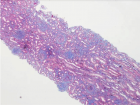Abstract
Opinion
The Indole acetic acid in bacteria, fungi and plants
Hernández-Mendoza JL*
Published: 17 November, 2022 | Volume 6 - Issue 3 | Pages: 161-162
Indole acetic acid (AIA) is the most important plant growth hormone since it intervenes in the mechanisms of cell growth and differentiation and is produced mostly in the meristematic zones of the plant for apical dominance or root growth. AIA is also produced in root nodules and plant galls. In the latter cases, its presence is associated with endophytic bacteria. Although it is a plant growth hormone, it is also produced by bacteria such as Azospirillum brasilense and Bradyrhizobium japonicum. These species live in the soil (rhizosphere) or can colonize the roots (endophytic) of their hosts. From these bacteria, there are also isolates that are nitrogen fixers, which in addition to providing growth factors to plants, contribute by releasing nitrogenous molecules that improve plant nutrition.
Read Full Article HTML DOI: 10.29328/journal.jpsp.1001091 Cite this Article Read Full Article PDF
References
Figures:

Figure 1
Similar Articles
-
Impact of Calcium Phosphate Nanoparticles on Rice PlantHrishikesh Upadhyaya*,Lutfa Begum,Bishal Dey,P K Nath,S K Panda. Impact of Calcium Phosphate Nanoparticles on Rice Plant. . 2017 doi: 10.29328/journal.jpsp.1001001; 1: 001-010
-
The Effects of Pharmacological Carbonic Anhydrase Suppression on Defence Responses of Potato Leaves To Phytophthora InfestansMagdalena Arasimowicz-Jelonek*,Jolanta Floryszak-Wieczorek. The Effects of Pharmacological Carbonic Anhydrase Suppression on Defence Responses of Potato Leaves To Phytophthora Infestans. . 2017 doi: 10.29328/journal.jpsp.1001002; 1: 011-025
-
Phytochemical content of leaf and stem of Marsilea quadrifolia (L.)Rajangam Udayakumar*,Karikalan Gopalakrishnan. Phytochemical content of leaf and stem of Marsilea quadrifolia (L.). . 2017 doi: 10.29328/journal.jpsp.1001003; 1: 026-037
-
Antagonistic features displayed by Plant Growth Promoting Rhizobacteria (PGPR): A ReviewMohsin Tariq*,Muhammad Noman,Temoor Ahmed,Amir Hameed,Natasha Manzoor,Marriam Zafar. Antagonistic features displayed by Plant Growth Promoting Rhizobacteria (PGPR): A Review . . 2017 doi: 10.29328/journal.jpsp.1001004; 1: 038-043
-
Wild-type Agrobacterium rhizogenes-mediated gene transfer in plants: Agrobacterium virulence and selection of transformantsShu Wei*,Muhammad Abdullah,Ferdinand L Shamalla,Mohammad M Rana. Wild-type Agrobacterium rhizogenes-mediated gene transfer in plants: Agrobacterium virulence and selection of transformants. . 2017 doi: 10.29328/journal.jpsp.1001005; 1: 044-051
-
Effects of Vochysia haenkeana extract on the neuromuscular blockade induced by Bothrops jararaca venom on chick biventer cervicis preparation in vitroYoko Oshima-Franco*,Fernanda Dias da Silva,Natália Tribuiani,Isadora Caruso Fontana Oliveira,Regina Yuri Hashimoto Miura,Rafael S Floriano,Márcio Galdino dos Santos,Sandro Rostelato-Ferreira. Effects of Vochysia haenkeana extract on the neuromuscular blockade induced by Bothrops jararaca venom on chick biventer cervicis preparation in vitro. . 2017 doi: 10.29328/journal.jpsp.1001006; 1: 052-058
-
HBV: Genomic Structure, HBVsAg Isolation and innovative Virotherapy Initiation in the Middle EastAboul-Ata E Aboul-Ata*,Essam M Janahi,I M El-Kalamawy,Kathleen Hefferon,Amal Mahmoud. HBV: Genomic Structure, HBVsAg Isolation and innovative Virotherapy Initiation in the Middle East . . 2017 doi: 10.29328/journal.jpsp.1001007; 1: 059-061
-
Physiological impact of Zinc nanoparticle on germination of rice (Oryza sativa L) seedUpadhyaya H*,Roy H,Shome S,Tewari S,Bhattacharya MK,Panda SK. Physiological impact of Zinc nanoparticle on germination of rice (Oryza sativa L) seed . . 2017 doi: 10.29328/journal.jpsp.1001008; 1: 062-070
-
Effects of Site Factors on the Clonal Growth of Phyllostachys bambusoides f. shouzhu YiXiaohong Gan*,Lijuan Chen,Cuibin Tang,Xia Zhang. Effects of Site Factors on the Clonal Growth of Phyllostachys bambusoides f. shouzhu Yi. . 2017 doi: 10.29328/journal.jpsp.1001009; 1: 071-079
-
Evaluation of genetic diversity in germplasm of paprika (Capsicum spp.) using random amplified polymorphic DNA (RAPD) markersRueda-Puente EO*,Renganathan P,Ruíz-Alvarado C,Hernández-Montiel LG,Prasath Duraisamy. Evaluation of genetic diversity in germplasm of paprika (Capsicum spp.) using random amplified polymorphic DNA (RAPD) markers. . 2017 doi: 10.29328/journal.jpsp.1001010; 1: 080-086
Recently Viewed
-
Investigate the Effect of Coating Concentration and Coating Thickness on the Anti-microbial Properties of Polycarbonate SheetSaleh Alkarri. Investigate the Effect of Coating Concentration and Coating Thickness on the Anti-microbial Properties of Polycarbonate Sheet. Ann Biomed Sci Eng. 2024: doi: 10.29328/journal.abse.1001029; 8: 011-020
-
The Importance of the Concept of Acute Pneumonia for Choosing the Principles of its Treatment and ResultsIgor Klepikov*. The Importance of the Concept of Acute Pneumonia for Choosing the Principles of its Treatment and Results. J Pulmonol Respir Res. 2024: doi: 10.29328/journal.jprr.1001051; 8: 003-008
-
Prospective Coronavirus Liver Effects: Available KnowledgeAvishek Mandal*. Prospective Coronavirus Liver Effects: Available Knowledge. Ann Clin Gastroenterol Hepatol. 2023: doi: 10.29328/journal.acgh.1001039; 7: 001-010
-
Adult Neurogenesis: A Review of Current Perspectives and Implications for Neuroscience ResearchAlex, Gideon S*,Olanrewaju Oluwaseun Oke,Joy Wilberforce Ekokojde,Tolulope Judah Gbayisomore,Martina C. Anene-Ogbe,Farounbi Glory,Joshua Ayodele Yusuf. Adult Neurogenesis: A Review of Current Perspectives and Implications for Neuroscience Research. J Neurosci Neurol Disord. 2024: doi: 10.29328/journal.jnnd.1001102; 8: 106-114
-
Plant growth, Yield and Leaf Nutritional value of Jute (Corchorus olitorius L.) as Influenced by Banana Peel levels under Salt Stress conditions in Coastal region of CameroonMathias Julien Hand*,Chimène Fanta Abib,Kingsley Mbi Tabi,Alphonse Ervé Nouck,Libert Brice Tonfack,Victor Désiré Taffouo,Emmanuel Youmbi. Plant growth, Yield and Leaf Nutritional value of Jute (Corchorus olitorius L.) as Influenced by Banana Peel levels under Salt Stress conditions in Coastal region of Cameroon. J Plant Sci Phytopathol. 2024: doi: 10.29328/journal.jpsp.1001145; 8: 131-140
Most Viewed
-
Evaluation of Biostimulants Based on Recovered Protein Hydrolysates from Animal By-products as Plant Growth EnhancersH Pérez-Aguilar*, M Lacruz-Asaro, F Arán-Ais. Evaluation of Biostimulants Based on Recovered Protein Hydrolysates from Animal By-products as Plant Growth Enhancers. J Plant Sci Phytopathol. 2023 doi: 10.29328/journal.jpsp.1001104; 7: 042-047
-
Sinonasal Myxoma Extending into the Orbit in a 4-Year Old: A Case PresentationJulian A Purrinos*, Ramzi Younis. Sinonasal Myxoma Extending into the Orbit in a 4-Year Old: A Case Presentation. Arch Case Rep. 2024 doi: 10.29328/journal.acr.1001099; 8: 075-077
-
Feasibility study of magnetic sensing for detecting single-neuron action potentialsDenis Tonini,Kai Wu,Renata Saha,Jian-Ping Wang*. Feasibility study of magnetic sensing for detecting single-neuron action potentials. Ann Biomed Sci Eng. 2022 doi: 10.29328/journal.abse.1001018; 6: 019-029
-
Physical activity can change the physiological and psychological circumstances during COVID-19 pandemic: A narrative reviewKhashayar Maroufi*. Physical activity can change the physiological and psychological circumstances during COVID-19 pandemic: A narrative review. J Sports Med Ther. 2021 doi: 10.29328/journal.jsmt.1001051; 6: 001-007
-
Pediatric Dysgerminoma: Unveiling a Rare Ovarian TumorFaten Limaiem*, Khalil Saffar, Ahmed Halouani. Pediatric Dysgerminoma: Unveiling a Rare Ovarian Tumor. Arch Case Rep. 2024 doi: 10.29328/journal.acr.1001087; 8: 010-013

HSPI: We're glad you're here. Please click "create a new Query" if you are a new visitor to our website and need further information from us.
If you are already a member of our network and need to keep track of any developments regarding a question you have already submitted, click "take me to my Query."
























































































































































